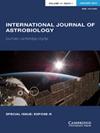Microbial protocols for spacecraft: 2. Biocidal effects of Delrin and nylon in sealed compartments may enhance bioburden reductions in planetary spacecraft
IF 1
4区 物理与天体物理
Q3 ASTRONOMY & ASTROPHYSICS
引用次数: 0
Abstract
Interplanetary spacecraft are assembled with thousands of parts composed of many diverse materials. Little is known on whether any of the spacecraft materials are biocidal to the typical microbiomes that develop on spacecraft during pre-launch processing. During ongoing experiments to examine the interactive effects of solar UV irradiation, solar heating, ionizing radiation, and vacuum, we observed that bacterial spores of three Bacillus spp. were killed when incubated within small vacuum chambers for 5 days – without exposure to the aforementioned factors. Eight potential spacecraft materials were tested within the vacuum chambers for biocidal activities against spores of B. atrophaeus ATCC 9372, B. pumilus SAFR-032 and B. subtilis 168. All three species were fully inactivated (i.e., no survivors detected) by machined parts manufactured from Delrin®; a thermoplastic polyacetal polymer. Although not tested here, it is known that Delrin can off-gas formaldehyde, and thus, we hypothesize that this volatile organic compound (VOC) was responsible for the biocidal activity of the material. Knowledge of the biocidal nature of routinely used spacecraft materials might offer diverse methods to inactivate deeply embedded or shielded microbiota within spacecraft via the release of biocidal VOCs.航天器微生物方案:2。Delrin和尼龙在密封舱中的生物杀灭作用可能会增强行星航天器中生物负载的减少
行星间航天器由数千个零件组装而成,这些零件由多种不同的材料组成。目前尚不清楚航天器材料是否对发射前处理过程中在航天器上形成的典型微生物群具有生物杀灭作用。在正在进行的研究太阳紫外线照射、太阳加热、电离辐射和真空相互作用的实验中,我们观察到三种芽孢杆菌的细菌孢子在小真空室内培养5天时被杀死,而不暴露于上述因素。在真空室内测试了八种潜在的航天器材料对B.atrophaeus ATCC 9372、B.pumilus SAFR-32和B.subtilis 168孢子的杀生物活性。所有三个物种都被Delrin®制造的机械加工零件完全灭活(即未检测到幸存者);一种热塑性聚缩醛聚合物。虽然这里没有测试,但已知Delrin可以释放甲醛气体,因此,我们假设这种挥发性有机化合物(VOC)是该材料的杀生物活性的原因。了解常规使用的航天器材料的杀生物性质可能会提供多种方法,通过释放杀生物挥发性有机物来灭活航天器内深埋或屏蔽的微生物群。
本文章由计算机程序翻译,如有差异,请以英文原文为准。
求助全文
约1分钟内获得全文
求助全文
来源期刊

International Journal of Astrobiology
地学天文-地球科学综合
CiteScore
3.70
自引率
11.80%
发文量
45
审稿时长
>12 weeks
期刊介绍:
International Journal of Astrobiology is the peer-reviewed forum for practitioners in this exciting interdisciplinary field. Coverage includes cosmic prebiotic chemistry, planetary evolution, the search for planetary systems and habitable zones, extremophile biology and experimental simulation of extraterrestrial environments, Mars as an abode of life, life detection in our solar system and beyond, the search for extraterrestrial intelligence, the history of the science of astrobiology, as well as societal and educational aspects of astrobiology. Occasionally an issue of the journal is devoted to the keynote plenary research papers from an international meeting. A notable feature of the journal is the global distribution of its authors.
 求助内容:
求助内容: 应助结果提醒方式:
应助结果提醒方式:


